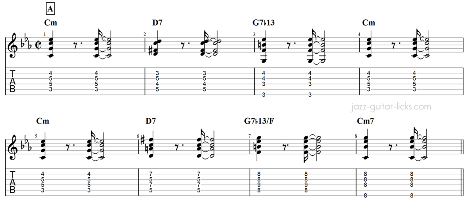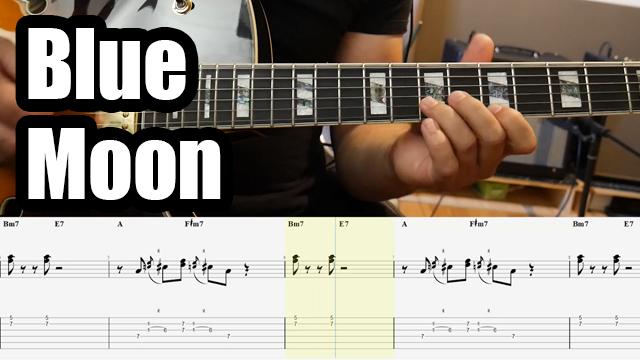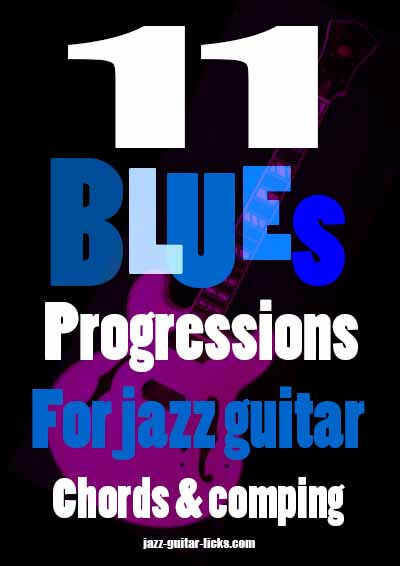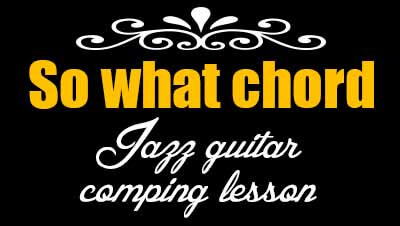comping
-
Solar By Miles Davis - 2 Chord Studies For Beginners
- By jazz-guitar-licks
- On 2023-05-23
- 0 comments
Here are two easy guitar chord studies to apply over the jazz tune Solar by Miles Davis. The first one implies 3-Note chords while the second implies 4-note chords. Free PDF and YouTube Short video available.
-
Armando's Rumba - Guitar Chords
- By jazz-guitar-licks
- On 2021-07-07
- 0 comments
This lesson provides a chord study with tab of the Latin jazz tune Armando's rumba by Chick Corea based on the Latin Real Book version in C minor. Here below you'll find guitar tabs corresponding to the four main parts of the tune (A-B-C-D).
The chords used in this arrangement are mostly seventh chords as min7, maj7, dim7 and dom7 (drop 2, drop 3 and rootless voicings) including basic triads (min, aug) and altered dominant chords (7#9, 7b13).
-
Polyrhythm Explained On Guitar
- By jazz-guitar-licks
- On 2020-09-19
- In Teacher Spotlight - Jazz Guitar Lessons
- 0 comments
Lesson by David Kennedy
This facebook post provides a YouTube video that details how to perform and compose on guitar with any polyrhythm. You will find a link to free resources, including the guitar score and tab in the video description.
Why exploring polyrhythm?
- It can deepen your understanding of rhythm and time signature.
- It’s a very useful tool for generating new rhythm ideas.
- It sounds really cool.
Don't hesitate go watch David's YouTube channel.
-
Blues Moon (Julie London / Howard Roberts) - Guitar Transcription With Tabs
- By jazz-guitar-licks
- On 2020-09-04
- In Licks & Transcriptions
- 0 comments
Here is a transcription (tabs, and standard notation) of the guitar comping played by Howard Roberts in the jazz standard Blue Moon with Julie London. You will find in the following:
- The original version.
- The YouTube video with the transcription and the tabs / notation overlayed.
- Four free png files.
-
Walking Bass Lines and Chords - Cheat Sheets
- By jazz-guitar-licks
- On 2020-04-13
- In Guitar Cheat Sheets, Methods, eBooks, Posters
- 0 comments
Here is a serie of guitar walking bass lines and chords cheat sheets for jazz comping.
-
Shell Voicings - Guide Tone Chords - 3-Note Chords - Guitar Lesson With Shapes
- By jazz-guitar-licks
- On 2020-04-07
- In Jazz Guitar Lessons
- 2 comments
Shell voicings are better known as 3-note chords (or guide tone chords).
They are made up of the most essential notes (root, third and seventh) that define a chord (the fifth is omitted).
They can very useful for beginner guitarists who want to explore basic guitar comping rhythms.
This lesson provides the essential chord shapes and exercises for practicing them on guitar.
-
Walking Bass Exercises For Jazz Guitar - Lesson With Tabs and Audio
- By jazz-guitar-licks
- On 2020-04-05
- In Jazz Guitar Lessons
- 2 comments
This concept highly prized by solo guitar players consists in mixing chords and bass lines.
It can be very useful for guitarists who want to accompany a singer or a soloist in a duo situation.
Guitar walking bass lines involve playing one note on each beat in order to make the link between the chords of a progression as a bass player would do.
They are usually played fingerstyle, basses are played with the thumb whereas the other chord tones are played with the fingers.
This free lesson with tabs and guitar shapes provides some easy examples.
-
NEW PDF eBook available | 11 blues-jazz progressions for guitar | Chords and comping studies
- By jazz-guitar-licks
- On 2017-02-12
- 0 comments
-
So What Chord - Jazz Rhythm Guitar Lesson - Modal Comping
- By jazz-guitar-licks
- On 2017-01-24
- 0 comments
Welcome to this lesson on one of the most iconic and modern-sounding chord voicings in jazz — the "So What" chord. Made famous by pianist Bill Evans on Miles Davis’s legendary tune "So What".
In this lesson, we’ll break down how to play the "So What" chord on the guitar, explore its structure, and learn how to move it around the neck.
Whether you're new to quartal harmony or looking to expand your chord vocabulary, this voicing will open up a fresh, sophisticated palette for your playing.








